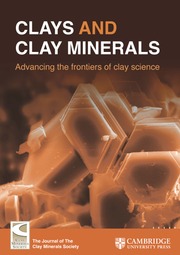Article contents
Atomic Force Microscopy Study of Hydrothermal Illite in Izumiyama Pottery Stone from Arita, Saga Prefecture, Japan
Published online by Cambridge University Press: 28 February 2024
Abstract
The surface microtopographic observations and analyses of Izumiyama hydrothermal illite particles were made by utilizing tapping-mode atomic force microscopy (TMAFM). The Izumiyama illite particles showed platy to lath shapes. Platy particles exhibited various spiral growth patterns, i.e. circular, malformed circular, or polygonal single unit-cell layer spirals, polygonal parallel step spiral, or interlaced spiral patterns. The polygonal parallel step spiral and interlaced spiral patterns are formed by two single unit-cell layers rotated by 180° and 120° arising from a single screw dislocation point, respectively. The spiral patterns indicate that the illite particles have 1M, 2O and 2M1 polytypes. Lath-shaped particles show only interlacing patterns supporting the formation of 2M1 structures.
Particles showing circular or malformed circular spirals were found to be thinner and to have narrower step separations than particles showing polygonal spirals. Polygonal platy and lath-shaped particles showing interlaced patterns tended to be thicker and to have wider step separations than the other polygonal platy particles.
These results suggest that the Izumiyama illites crystallize as the result of a mechanism involving solution-mediated polytypes and spiral-type transformations of illite. The mechanism involves the Ostwald ripening process, i.e. a transformation of the polytype and spiral shape. The sequence of crystallization of the Izumiyama illite is: 1M circular spirals → 1M, 2O polygonal spirals → 2M1 polygonal spirals occurring during crystal growth and sequentially overgrowing on the initial particle surfaces. The super-saturation of the hydrothermal solution probably decreases gradually during the transformation, and this decrease may cause not only the transformation from a circular to a polygonal crystal morphology but also the development of a lath habit due to the inhibition of the growth rate in the [010] direction of the particle.
Keywords
- Type
- Research Article
- Information
- Copyright
- Copyright © 2001, The Clay Minerals Society
References
- 17
- Cited by


